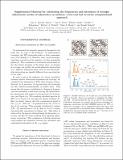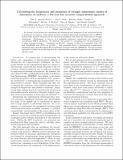Files in this item
Calculating the frequencies and intensities of strongly anharmonic modes of adsorbates on surfaces : a low-cost but accurate computational approach
Item metadata
| dc.contributor.author | Garrido Torres, José A. | |
| dc.contributor.author | Goetze, Jan P. | |
| dc.contributor.author | Grillo, Federico | |
| dc.contributor.author | Richardson, Neville V. | |
| dc.contributor.author | Früchtl, Herbert A. | |
| dc.contributor.author | Hooley, Chris A. | |
| dc.contributor.author | Schaub, Renald | |
| dc.date.accessioned | 2019-06-27T16:30:07Z | |
| dc.date.available | 2019-06-27T16:30:07Z | |
| dc.date.issued | 2019-07-25 | |
| dc.identifier | 259389060 | |
| dc.identifier | 1a23913d-2002-48d8-9d0f-c8214de649de | |
| dc.identifier | 000477888200006 | |
| dc.identifier | 85073645767 | |
| dc.identifier.citation | Garrido Torres , J A , Goetze , J P , Grillo , F , Richardson , N V , Früchtl , H A , Hooley , C A & Schaub , R 2019 , ' Calculating the frequencies and intensities of strongly anharmonic modes of adsorbates on surfaces : a low-cost but accurate computational approach ' , Physical Review. B, Condensed matter and materials physics , vol. 100 , no. 3 , 035433 . https://doi.org/10.1103/PhysRevB.100.035433 | en |
| dc.identifier.issn | 1098-0121 | |
| dc.identifier.other | ORCID: /0000-0002-9976-2405/work/60426779 | |
| dc.identifier.other | ORCID: /0000-0001-9961-1212/work/60427078 | |
| dc.identifier.other | ORCID: /0000-0001-6647-4266/work/60887475 | |
| dc.identifier.uri | https://hdl.handle.net/10023/17995 | |
| dc.description | Funding: Scottish Funding Council (through EaStCHEM and SRD-Grant HR07003) and from EPSRC (PhD studentship for JAGT, EP/M506631/1). | en |
| dc.description.abstract | We present a new method for calculating the frequencies and intensities of the vibrational modes of adsorbates on surfaces. Our method is based on density functional perturbation theory (DFPT) and provides accurate estimates of the vibrational intensities even when the vibrations are strongly anharmonic. Furthermore, it does so at a negligible additional computation cost compared to conventional DFPT calculation. We illustrate our method by calculating the vibrational spectra of three example systems — ethylidyne on Rh(111), benzene on Rh(111) coadsorbed with CO, and terephthalic acid (TPA) on Cu(100) — and comparing them to experimental measurements performed using High-Resolution Electron Energy Loss Spectroscopy (HREELS). We find excellent agreement between our predictions and the experimentally measured frequencies and intensities in all three cases. | |
| dc.format.extent | 786043 | |
| dc.format.extent | 1092818 | |
| dc.language.iso | eng | |
| dc.relation.ispartof | Physical Review. B, Condensed matter and materials physics | en |
| dc.subject | QC Physics | en |
| dc.subject | QD Chemistry | en |
| dc.subject | NDAS | en |
| dc.subject.lcc | QC | en |
| dc.subject.lcc | QD | en |
| dc.title | Calculating the frequencies and intensities of strongly anharmonic modes of adsorbates on surfaces : a low-cost but accurate computational approach | en |
| dc.type | Journal article | en |
| dc.contributor.sponsor | Scottish Funding Council | en |
| dc.contributor.institution | University of St Andrews. School of Chemistry | en |
| dc.contributor.institution | University of St Andrews. EaSTCHEM | en |
| dc.contributor.institution | University of St Andrews. Centre for Designer Quantum Materials | en |
| dc.contributor.institution | University of St Andrews. Condensed Matter Physics | en |
| dc.contributor.institution | University of St Andrews. School of Physics and Astronomy | en |
| dc.identifier.doi | 10.1103/PhysRevB.100.035433 | |
| dc.description.status | Peer reviewed | en |
| dc.identifier.grantnumber | SCISS HR07003 | en |
This item appears in the following Collection(s)
Items in the St Andrews Research Repository are protected by copyright, with all rights reserved, unless otherwise indicated.


